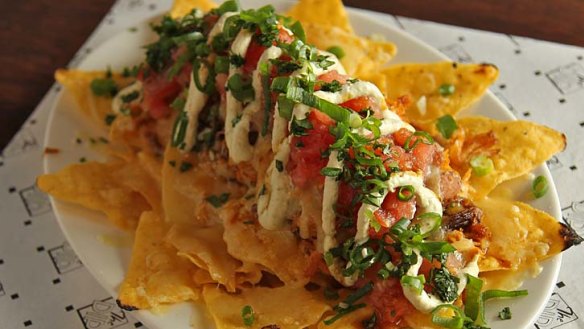Where do nachos come from?

Where do nachos come from? P. Shepherd
If you live in a Spanish-speaking country and your parents named you Ignacio, there's a good chance your school friends will call you Nacho, just as Francisco is Paco and Juan Jose is Juanjo. Most American sources attribute nachos to a bloke called Nacho Anaya, who was working in the Victory Club in Ciudad Acuna, a border town in Mexico. The story goes that one day in 1943 the wives of US servicemen popped over the border for some food. Arriving late, there was little to serve them, so Nacho whipped up what he had left: some corn chips, cheese and jalapeno chillies. Nachos were born. The Diccionario Enciclopedico de Gastronomia Mexicana by Ricardo Munoz Zurita, however, says nachos are made from totopos - day-old corn tortillas that are cut into eighths, deep-fried and served with melted manchego cheese, serrano chillies and tomato sauce and eaten as a snack in the northern state of Monterrey. Munoz says its origins are ''estadounidense'', or American. It seems neither side wants to take the blame.
My problem with schnitzel is that the breadcrumbs just fall off the chicken. Enno
I have to apologise to the chicken parma lovers I offended a few weeks back with the disparaging comments I made about the dish. How anyone could have affection for what essentially is an over-topped pizza with a massive flattened chicken nugget for a base is beyond me, but each to their own. So Enno, after pounding out your chicken thigh fillets between two pieces of plastic film, dip them into seasoned plain flour, then egg wash made with beaten egg and milk. Let the excess wash drip off, then generously dredge the chicken in breadcrumbs. Fry gently and move the schnitzel about with a flat spatula. If you have a large schnitzel, use a thin egg flip to support it. If it bends, the breadcrumbs may break and fall away. Some establishments make up a thin tempura batter and dip the floured meat into this, then into the breadcrumbs.
Is it OK to buy dark-coloured beef? D. Philips
Recently I ate what was one of the best steaks I have ever had. The flesh was deep, dark red - almost mahogany - and came from an old dairy cow that was 14 years old. It was quite extraordinary on so many levels. The beef we eat in Australia is generally about a year to 18 months and will be a healthy light red. Darker beef will indicate a few things. It could come from an older animal, in which case you would want to ask your butcher if it was aged, which would help its flavour and texture potential. Dry-ageing meat will cause the flesh to go dark, particularly near where the muscle has been exposed to air for several weeks. There is a phenomenon called ''dark cutting meat'' and this is caused by low muscle sugar levels in the cattle prior to slaughter, due to poor feed or stress. The meat, when cut, remains dark and almost bruised-looking and will not keep very well. It will go slimy quickly and will lose a lot of moisture when cooked, resulting in dry meat.
Can I reuse leftover marinade? E. Ross
Preferably not. Well, not as a marinade, anyway. After hours of raw meat or fish sitting around in the marinade, it may have expelled some meat juice and shed some bacteria that may enjoy its new home. Leftover marinade can be simmered for five minutes and brushed over the food it was marinating to kill bacteria and make a glaze. If there is a lot of sugar or fruit in the marinade, then brush the glaze towards the end of the cooking time, otherwise the sugar may char.
Letters
A few weeks ago we listed a website where one could buy papaya-based meat tenderiser. Thanks to LP who wrote in with: "For a good papaya-based meat tenderiser, just pop into any Indian grocery store and pick up Shan or another brand meat tenderiser. Costs a fraction of what the other fancy places will charge you … you don't even need to call it papain or proteinase or whatever." Thanks also to those who wrote in suggesting the unfortunately named Adolph's Meat Tenderizer, which is made with a pineapple-based enzyme.
Send queries to brainfood@richardcornish.com.au or leave them in the comments below.
The best recipes from Australia's leading chefs straight to your inbox.
Sign up- More:
- Brain food
